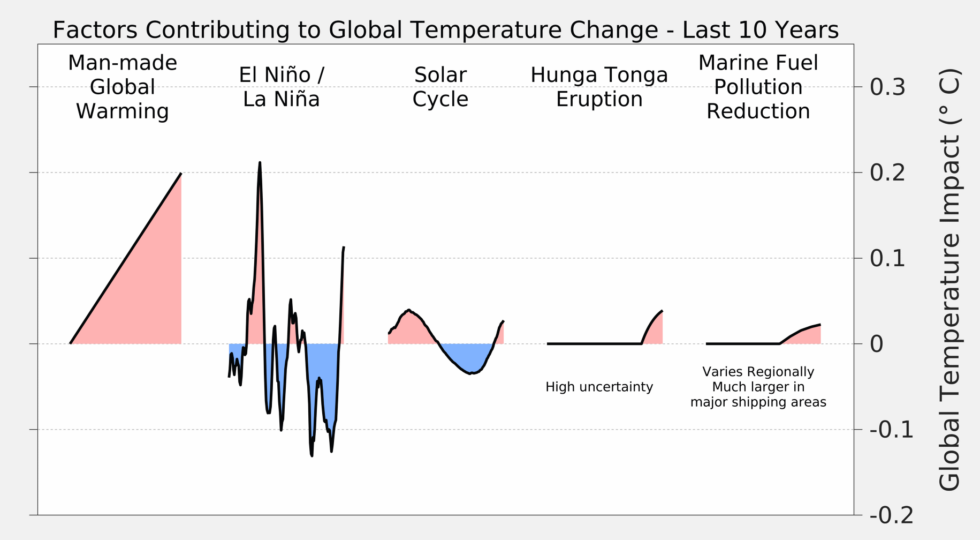[ad_1]

Earlier this week, the European Union’s Earth science staff got here out with its evaluation of 2023’s world temperatures, discovering it was the warmest yr on file up to now. In an period of world warming, that is not particularly stunning. What was uncommon was how 2023 set its file—each month from June on coming in far above any equal month prior to now—and the dimensions of the hole between 2023 and any earlier yr on file.
The Copernicus dataset used for that evaluation is not the one one of many type, and on Friday, Berkeley Earth, NASA, and the Nationwide Oceanic and Atmospheric Administration all launched equal studies. And all of them largely agree with the EU’s: 2023 was a file, and an uncommon one at that. So uncommon that NASA’s chief local weather scientist, Gavin Schmidt, launched his have a look at 2023 by saying, “We’re frankly astonished.”
Regardless of the overlaps with the sooner evaluation, every of the three new ones provides some particulars that flesh out what made final yr so uncommon.
Every of the three analyses makes use of barely totally different strategies to do issues like fill in areas of the globe the place information are sparse, and makes use of a special baseline. Berkeley Earth was the one staff to do a comparability with pre-industrial temperatures, utilizing a baseline of the 1850–1900 temperatures. Its evaluation means that that is the primary yr to complete over 1.5° C above preindustrial temperatures.
Most nations have dedicated to an try to maintain temperatures from constantly coming in above that time. So, at one yr, we’re removed from constantly failing our targets. However there’s each motive to count on that we’ll see a number of extra years exceeding this level earlier than the last decade is out. And that clearly means we now have a really brief timeframe earlier than we get carbon emissions to drop, or we’ll decide to going through a tough battle to get temperatures again underneath this threshold by the tip of the century.
Berkeley Earth additionally famous that the warming was extraordinarily widespread. It estimates that just about a 3rd of the Earth’s inhabitants lived in a area that set a neighborhood warmth file. And 77 nations noticed 2023 set a nationwide file.

The Berkeley staff additionally had a pleasant graph laying out the influences of various components on current warming. Greenhouse gases are clearly the strongest and most constant issue, however there are weaker short-term influences as properly, such because the El Niño/La Niña oscillation and the photo voltaic cycle. Berkeley Earth and EU’s Copernicus additionally famous that a world settlement precipitated sulfur emissions from transport to drop by about 85 p.c in 2020, which would scale back the quantity of daylight scattered again out into house. Lastly, just like the EU staff, they observe the Hunga Tonga eruption.
An El Niño in contrast to another
A shift from La Niño to El Niño situations within the late spring is highlighted by everybody taking a look at this yr, as El Niños are likely to drive world temperatures upward. Whereas it has the potential to turn into a powerful El Niño in 2024, for the time being, it is fairly delicate. So why are we seeing file temperatures?
We’re not solely positive. “The El Niño we have seen shouldn’t be an distinctive one,” mentioned NASA’s Schmidt. So, he reasoned, “Both this El Niño is totally different from all of them… or there are different components occurring.” However he was at a little bit of a loss to determine the components. He mentioned that usually, there are a restricted variety of tales that you just maintain selecting from with the intention to clarify a given yr’s conduct. However, for 2023, none of them actually match.

Berkeley Earth had a terrific instance of it in its graph of North Atlantic sea floor temperatures, which have been rising slowly for many years, till 2023 noticed file temperatures with a freakishly massive hole in comparison with something beforehand on file. There’s nothing particularly apparent to elucidate that.
Lurking within the background of all of that is local weather scientist James Hansen’s argument that we’re about to enter a brand new regime of world warming, the place temperatures enhance at a a lot quicker tempo than they’ve till now. Most local weather scientists do not see compelling proof for that but. And, with El Niño situations prone to prevail for a lot of 2024, we are able to count on a extremely popular yr once more, no matter altering tendencies. So, it might take a number of extra years to find out if 2023 was a one-off freak or an indication of latest tendencies.
[ad_2]